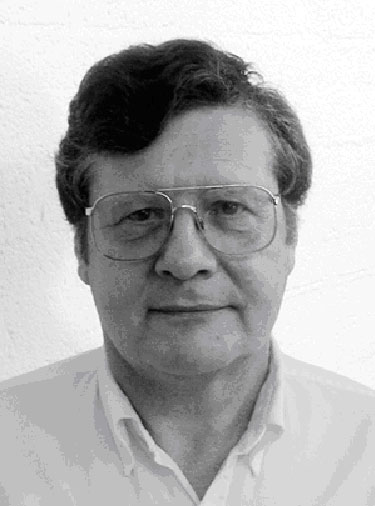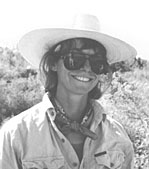2002-2003
Prehistoric Art
Art is a cultural universal that captivates anthropologists, art historians, other artists, and the public at large. Why and for whom was art created? How true is art as a window into the past--the past of cultures and individuals and events? Does art speak to broader issues of thought, cognition, and style? Are these concerns ones we can understand in the absence of direct experience with the artist? That is, can we go beyond art appreciation to the underpinnings of society, a culture, now long gone?
Whatever the medium, prehistoric art is the preserved, intended visual representation
of daily life, people, ideals, hopes, cosmology, experiences and things-real and imagined.
Prehistoric art is our strongest link to, and our most tangible expression of a person,
a group, and a time before written history. Prehistoric art is a puzzle wrapped in
a mystery. Our purpose is to unwrap the enigma and to celebrate the art, the artist,
and the cultures that created them.
This year's lectures address different aspects of prehistoric North American art.
Because archaeologists consider art in ways almost as varied as the art itself, we
chose to showcase many forms of artistic expression and evaluation. We begin with
one of the larger puzzles of North American prehistory, the art and complex, agrarian
societies of the American Midwest and Southwest from the time before Columbus some
600 or more years ago. The first two lectures deal with the tangled net these societies
cast. In November, Dr. Emerson speaks about Cahokia, the largest prehistoric town
north of Mexico which is across the Mississippi River from present day St. Louis,
Missouri, and its artistic and social connections to Spiro, its amazing Great Mortuary
and mound center. Spiro is on the Poteau River before it joins the Arkansas River
just west of Fort Smith, Arkansas, in east Oklahoma. In March, Dr. Hegmon continues
this assessment by an examination of puebloan cultures of the American Southwest.
In April, Dr. Sundstrom assesses Northern Plains rock art and its implications for
charting culture change and cosmology.
We invite you to meet our speakers at the informal receptions held in their honor following their lectures.
November 21, 2002

Thomas E. Emerson, Ph.D.
Director and Adjunct Professor, Illinois Transportation Archaeological Research Program, Department of Anthropology, University of Illinois
Lecture:
Art and Its Material Sources: the Cahokia-Spiro Connections
Giffels Auditorium
7:30 p.m.
Thomas E. Emerson is a senior Midwestern archaeologist who has devoted much of his professional career to the evaluation of late prehistoric complex society. His current administrative responsibilities include the direction and management of Illinois statewide archaeological, historical, and architectural programs. His view of the Mississippian Period urban center of Cahokia now constitutes one of two competing ideas about the development of ranked society in the southeastern United States, and the collapse of the Cahokian polity as a result of rapid political failure. His research of the Crow Creek massacre in South Dakota also was a catalyst in recognizing the scope of pre-Columbian warfare. Dr. Emerson is a graduate of University of Wisconsin, Madison, from 1984-1994 was Chief Archaeologist, Illinois Historic Preservation Agency, and has held teaching positions at University of South Dakota and Belloit College. The National Science Foundation supports his current research on sourcing flintclays from which Cahokian style figures were sculpted. He publishes widely and extensively on Midwestern and Plains archaeology, is the editor of nine celebrated volumes on Midwestern prehistory, and has edited the journals South Dakota Archaeology and Illinois Archaeology. Among his more recent publications are two books from 1997, Cahokia: Ideology and Domination in the Mississippian World (edited with T. Pauketat) and Cahokia and the Archaeology of Power.
March 6 , 2003

Michelle Hegmon, Ph.D.
Associate Professor, Department of Anthropology, Arizona State University, Tempe
Lecture:
Culture, Style and Technology in Southwest Archaeology
Giffels Auditorium, Old Main
7:30 p.m.
Michelle Hegmon's career in Southwest archaeology is truly stellar. Her graduate education at the University of Michigan advanced a more general interest in artifact style as a social strategy. She also is proficient in the technology of ceramics, one of the mainstays of Southwest archaeology and crucial to her research of its Mimbres culture. Since 1996, she and Margaret C. Nelson have received two major multiyear grants from the Turner Foundation for their Mimbres research. Other related grants have come from National Geographic Society, and doctoral dissertation improvement grants for her students from the National Science Foundation. While centered in the Southwest, Dr. Hegmon's research knows no geographic boundaries and is widely published. Her research showcases gender in archaeology, the archaeology of the social realm, food production and village communities, regional exchange and interaction, and style and material culture. These concerns reflect modern theoretical trends in American archaeology. Her scholarship and forceful, persuasive advocacy of these issues are balanced by a well-appreciated keen sense of humor. Prior to coming to Arizona State University, Dr. Hegmon taught at New Mexico State University, Las Cruces. Her most recent book, published in 2000 by University Press of Colorado, is the edited volume, The Archaeology of Regional Interaction: Religion, Warfare and Exchange in the American Southwest.
March 17 , 2003

Vernon James Knight, Ph.D.
Professor of Anthropology, University of Alabama, Tuscaloosa
Lecture:
Art and the Cosmos of the Native American Southeast
Auditorium of the Science Engineering Building
7:30 p.m.
Professor Knight is a gifted speaker who brings a wealth of experience to this subject. He and his colleagues have published widely and persuasively about the Southeastern Ceremonial Complex. Its imagery of otherworldly beings includes bird serpents, bird-men, human-headed snakes, and other fanciful creations. In Oklahoma just west of Fort Smith, Arkansas is Spiro, where a central element of the Southeastern Ceremonial Complex is identified as the Classic Braden style complex of engraved objects of marine shell and copper; its iconic connections span much of the American Southeast. This complex represents a vital element of prehistoric art in eastern North America found most spectacularly at Spiro, at Etowah, Georgia, at Cahokia, Illinois, and at Moundville, Alabama, where Knight has devoted much of his professional career. The Smithsonian Institution Press volume, Studies in Moundville Archaeology, published in 1998 and co-edited by Knight and Vincas P. Steponaitis is a primary source on this site. This volume is a natural outgrowth of Knight's doctoral dissertation, Mississippian Ritual, completed in 1981 at the University of Florida. In 2001, Knight, James A. Brown, and George E. Lankford published the seminal article, "On the subject matter of Southeastern Ceremonial Complex art," in the journal Southeastern Archaeology. The more than half century of lively debate about this complex's meaning undoubtedly will continue. Knight and his colleagues' efforts have shifted this debate to the underlying ritual structure of Southeastern Ceremonial Complex art.
A Special Dedication
The 2002-2003 Stigler lectures are special to us for a number of reasons. Not least is the role Allen P. McCartney has played in their inception and development.
Allen is a pivotal figure in Arctic archaeology and in the study of human adaptations to maritime environments. His research is sponsored by grants from National Science Foundation, National Endowment for the Humanities, National Geographic Society, and by branches of the Canadian government. Over 60 publications showcase his many contributions to Arctic studies. He is a co-author of the Smithsonian Institution's Handbook of North American Indians Volume 5 -Arctic. For much of the past two decades he edited the international journal, Arctic Anthropology. Allen chaired the Department of Anthropology for several years and, in the mid-1980s, was asked by Bob Stigler's parents if the department would be interested in inaugurating this lectureship. After consultation with the department faculty, who unanimously agreed, Allen said we would be delighted.
From its inception in 1987 until spring of 2002 Allen chaired the Robert L.Stigler, Jr. lecture committee. He remains the driving force behind the lectures. His good humor and compassion for friends, colleagues, students, and the public is a prime reason the lectureship attracts world-renowned scholars. Allen's self-effacing and congenial way always ensures the best possible environment both for the lecturers and those who come to hear them. Harry S Truman's notion that one can do ever so much as long as he does not take the credit, is clearly Allen's philosophy too; and one we continue to emulate.
Parkinson's disease has forced Allen to cut back on his participation in the lectureship and other university activities. Allen's interests have been constant and remain the well-being of others, and the promotion of knowledge about landscapes and people. His legacy justifiably centers on the Arctic. For us this lectureship is a vision of what anthropology and archaeology contribute to understanding our planet; it's Allen's vision.